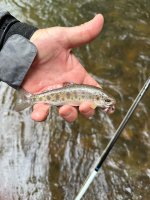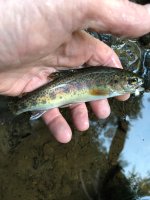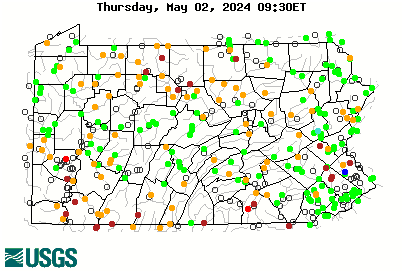You are using an out of date browser. It may not display this or other websites correctly.
You should upgrade or use an alternative browser.
You should upgrade or use an alternative browser.
Wild Trout Trifecta
- Thread starter TroutLife
- Start date
Prospector
Well-known member
I’ve done it 4 times on the same day. None this year. I haven’t fished the streams where it is possible.
The streams where it is possible should probably have an extra layer of protection. About 3-4 years ago I found where AMD was entering the headwaters of one of these streams. The agency I eventually talked to never followed up with me.
The streams where it is possible should probably have an extra layer of protection. About 3-4 years ago I found where AMD was entering the headwaters of one of these streams. The agency I eventually talked to never followed up with me.
Last edited:
If you don’t mind me asking - what county in PA did you catch the wild bows?I’ve done it 4 times on the same day. None this year. I haven’t fished the streams where it is possible.
The streams where it is possible should probably have an extra layer of protection. About 3-4 years ago I found where AMD was entering the headwaters of one of these streams. The agency I eventually talked to never followed up with me.
wildtrout2
Well-known member
I've gotten the wild trout trifecta a few times, also in the NW region of Pa. Not many streams have all three wild/native trout, so it's a neat accomplishment.
gulfgreyhound
Well-known member
- Joined
- Oct 17, 2007
- Messages
- 6,350
Well done. GG
Cougarbaby
Well-known member
I did it on little J 2 years ago I hope they were all wild looked like it to me as the Brooke was 5-6 inches
bikerfish
Well-known member
- Joined
- May 29, 2009
- Messages
- 3,645
Ive done it a few times, and a few times in one day. I'm sure I fished the same drainage as prospector, I know the area well. I fished there a about a month ago, streams a little high, which was nice to see after a few years of low water, got brookies and rainbows, no browns though this time. I will fish it again this fall if water conditions are decent.
Cougarbaby
Well-known member
Nice I can't seem to get out enough this year
6xAdams(Jones)
Well-known member
The OP says Elk Co.If you don’t mind me asking - what county in PA did you catch the wild bows?
The_Sasquatch
Well-known member
I've done it in NCPA-but like you, the wild bow is what surprised me. I guess it shouldn't. If the state stocks rainbows over wild populations, it's inevitable that at some point, some of those fish will successfully spawn-even if the population never becomes established.
bigjohn358
Well-known member
Most of the time I see what claims to be "wild" rainbows tends to be fingerling stockings. Wild rainbows rarely occur here in PA. Those fingerlings move a long distance from where they were stocked.
Couldn’t agree more. I’m always amazed at the difficulty some fisherman have at identifying wild trout.Most of the time I see what claims to be "wild" rainbows tends to be fingerling stockings. Wild rainbows rarely occur here in PA. Those fingerlings move a long distance from where they were stocked.
The_Sasquatch
Well-known member
What are ways you'd determine between a fingerling stocked rainbow, especially one caught in streams that don't have known fingerling stocking programs, and a truly wild small 'bow?Most of the time I see what claims to be "wild" rainbows tends to be fingerling stockings. Wild rainbows rarely occur here in PA. Those fingerlings move a long distance from where they were stocked.
Last edited:
1. Perfect, Intact Fins (Especially the Adipose and Caudal Fins) -The adipose fin on this trout is small and clean—not eroded or clipped
2. Coloration and Spot Pattern -Wild rainbows often have darker, more vivid patterns and clear parr marks (those vertical bars on the side of juveniles), which this fish displays. Hatchery rainbows tend to look paler or more uniform in color, as their environment lacks natural substrate and hiding cover.
The spots are natural-looking, well-defined, and spread along the entire length of the body. Including the blue spot on the cheek
3. Stream Type and Habitat
- It was caught in a remote, lightly pressured headwater on a Class A stream in the PA Wilds.
4. Lastly I I have a good friend who’s an ichthyologist and professor at PSU. After I shared my experience, he expressed interest in investigating the population further in a future study.
2. Coloration and Spot Pattern -Wild rainbows often have darker, more vivid patterns and clear parr marks (those vertical bars on the side of juveniles), which this fish displays. Hatchery rainbows tend to look paler or more uniform in color, as their environment lacks natural substrate and hiding cover.
The spots are natural-looking, well-defined, and spread along the entire length of the body. Including the blue spot on the cheek
3. Stream Type and Habitat
- It was caught in a remote, lightly pressured headwater on a Class A stream in the PA Wilds.
4. Lastly I I have a good friend who’s an ichthyologist and professor at PSU. After I shared my experience, he expressed interest in investigating the population further in a future study.
Attachments
Studying the population with what intent regarding management?Lastly I I have a good friend who’s an ichthyologist and professor at PSU. After I shared my experience, he expressed interest in investigating the population further in a future study.
Would the goal be to increase wild rainbow populations? Or eradicate them? Or something else?
The majority of PFBC stocked rainbows are sterile females, and the remainder are fall spawning strains who’s eggs are very unlikely to survive the winter.I've done it in NCPA-but like you, the wild bow is what surprised me. I guess it shouldn't. If the state stocks rainbows over wild populations, it's inevitable that at some point, some of those fish will successfully spawn-even if the population never becomes established.
If wild rainbows are found in PA, it’s because the water doesn’t get below 37 degrees in the winter, or in the case of a few wild rainbow streams in my neck of the woods, they are the result of a private hatchery raising a spring spawning strain of rainbows.
To estimate the population and study the geneticsStudying the population with what intent regarding management?
Would the goal be to increase wild rainbow populations? Or eradicate them? Or something else?






